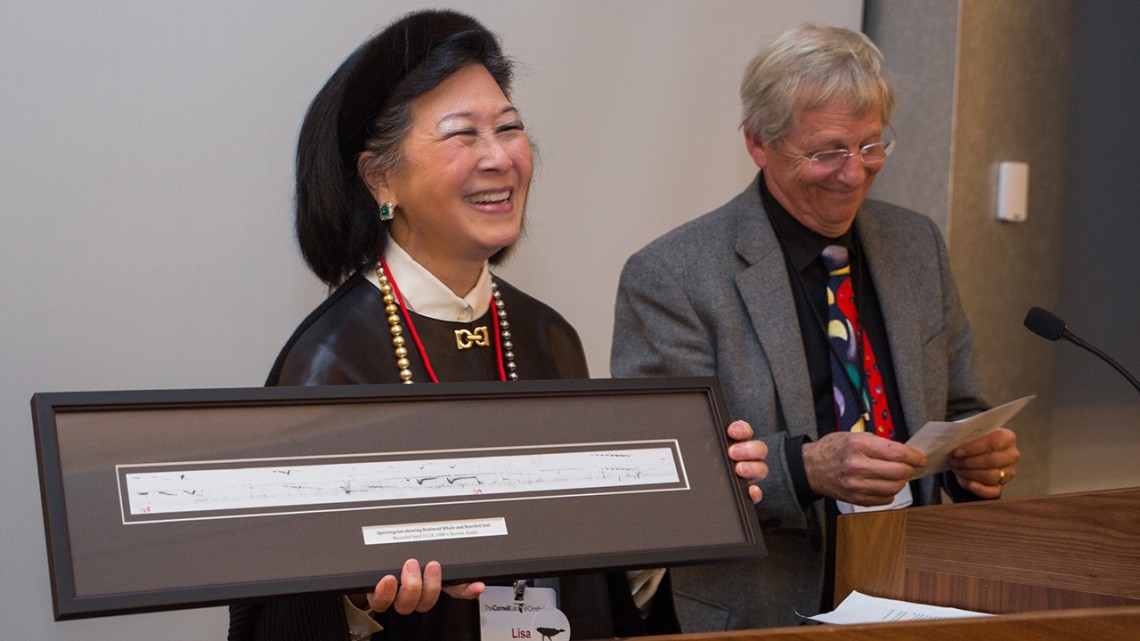
K. Lisa Yang holds a framed spectrogram of a bowhead whale recording as she stands next to Chris Clark.
New $1.5M fellowship honors bioacoustics pioneer
By Pat Leonard
A new $1.5 million gift from philanthropist K. Lisa Yang ’74 has established the Christopher W. Clark Postdoctoral Fellowship in Conservation Bioacoustics in honor of Clark, the retired director of the bioacoustics program at the Cornell Lab of Ornithology.
The announcement of the new postdoctoral position came at a dinner in early November launching the K. Lisa Yang Center for Conservation Bioacoustics. Yang had recently donated $24 million to the program, which includes the John W. Fitzpatrick Directorship, named for the lab’s long-time executive director. The additional gift in Clark’s name came about after Yang dug deeper into bioacoustics history.
“When I started to get serious about solidifying the status of conservation bioacoustics technology,” she said, “I got the background on how instrumental Chris was in establishing and being a pioneer in the field over decades. I felt we shouldn’t lose the narrative on that history.”
That history covers Clark’s 30 years at the Lab of Ornithology, growing the bioacoustics unit from two people to at least 50 today. It also includes groundbreaking new tools to collect the sounds of the natural world (the “singing planet,” as Clark refers to it), and new ways of analyzing the deluge of acoustic data collected by autonomous recording units deployed in inaccessible and largely hidden locations throughout the world.
At the dinner, Yang was given a framed strip of paper showing a spectrogram of singing bowhead whales and bearded seals recorded from beneath the frozen Arctic Ocean off Point Barrow, Alaska, back in the “old days.” The notations on the paper are in Clark’s handwriting. He had to use a ruler to manually measure frequency, duration, and other characteristics of the sound. These tasks are all fully automated in today’s digital world, using software tools created in the K. Lisa Yang Center for Conservation Bioacoustics.
Along with continued expansion of the Center’s bioacoustic work around the world, Clark hopes information collected from the U.S. Navy’s underwater listening network will become available for bioacoustics research. As a civilian marine mammal expert, Clark is one of only a handful of people with access to acoustic observations from the Atlantic and Pacific oceans – observations that would permit the study of bioacoustic habitats over vast scales.
“The system is the Hubble Telescope of underwater acoustics,” Clark said. “There are acoustic phenomena occurring that no one has ever heard before. The underwater acoustic scenes are enchanting with rich deposits of information awaiting scientific exploration and synthesis.”
But Clark’s contribution to bioacoustics extends well beyond hardware and software, Yang said.
“When you think about what Chris did, his accomplishments are not only in bioacoustics technology but in mentoring,” she said. “So many people at the lab know him and are so fond of him that I thought we really needed to do something to recognize that he created the foundation for bioacoustics at the lab.”
“Chris has always been committed to fostering the next generation of leaders in our field,” said Holger Klinck, the current director of the K. Lisa Yang Center for Conservation Bioacoustics. “Throughout his long tenure at Cornell, Chris trained many graduate students and postdocs who went on to leadership positions in state and federal agencies or at other universities. In this spirit, the newly established postdoctoral fellowship represents a long-term commitment to training the most promising young minds in conservation bioacoustics.”
Clark said he is looking forward to seeing the growth and creativity of the next generation of conservation scientists.
“Success is seeing others go beyond anything you could have done,” he said. “That’s the greatest gift I’ve received from all this. There’s a boundless cornucopia of opportunities for discovery and for falling in love with the natural world.”
Pat Leonard is a staff writer for the Cornell Lab of Ornithology.
Media Contact
Get Cornell news delivered right to your inbox.
Subscribe
